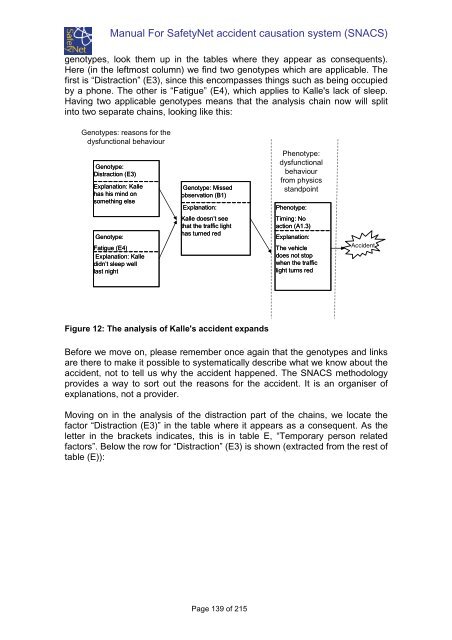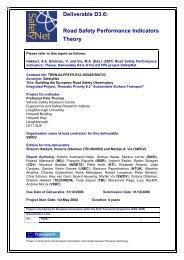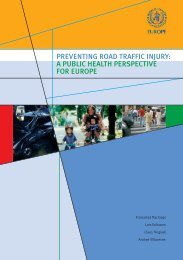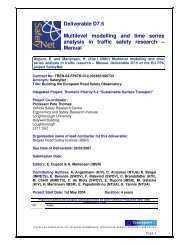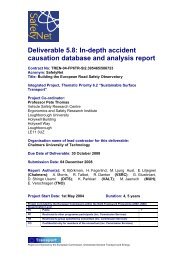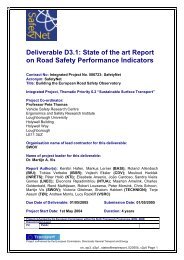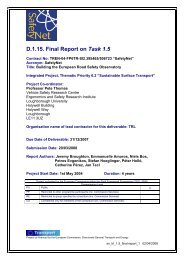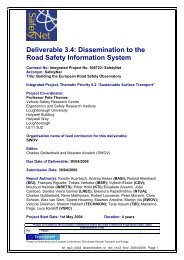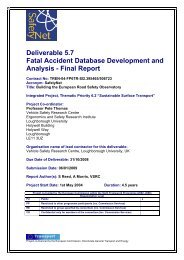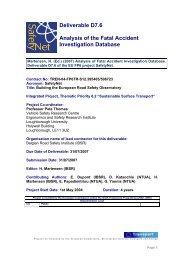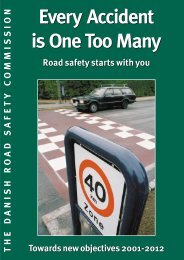Glossary of Data Variables for Fatal and accident causation ... - ERSO
Glossary of Data Variables for Fatal and accident causation ... - ERSO
Glossary of Data Variables for Fatal and accident causation ... - ERSO
Create successful ePaper yourself
Turn your PDF publications into a flip-book with our unique Google optimized e-Paper software.
Manual For SafetyNet <strong>accident</strong> <strong>causation</strong> system (SNACS)<br />
genotypes, look them up in the tables where they appear as consequents).<br />
Here (in the leftmost column) we find two genotypes which are applicable. The<br />
first is “Distraction” (E3), since this encompasses things such as being occupied<br />
by a phone. The other is “Fatigue” (E4), which applies to Kalle's lack <strong>of</strong> sleep.<br />
Having two applicable genotypes means that the analysis chain now will split<br />
into two separate chains, looking like this:<br />
Genotypes: reasons <strong>for</strong> the<br />
dysfunctional behaviour<br />
Genotype:<br />
Distraction (E3)<br />
Explanation: Kalle<br />
has his mind on<br />
something else<br />
Genotype: Missed<br />
observation (B1)<br />
Explanation:<br />
Phenotype:<br />
dysfunctional<br />
behaviour<br />
from physics<br />
st<strong>and</strong>point<br />
Phenotype:<br />
Genotype:<br />
Fatigue (E4)<br />
Explanation: Kalle<br />
didn’t sleep well<br />
last night<br />
Kalle doesn’t see<br />
that the traffic light<br />
has turned red<br />
Timing: No<br />
action (A1.3)<br />
Explanation:<br />
The vehicle<br />
does not stop<br />
when the traffic<br />
light turns red<br />
Accident<br />
Figure 12: The analysis <strong>of</strong> Kalle's <strong>accident</strong> exp<strong>and</strong>s<br />
Be<strong>for</strong>e we move on, please remember once again that the genotypes <strong>and</strong> links<br />
are there to make it possible to systematically describe what we know about the<br />
<strong>accident</strong>, not to tell us why the <strong>accident</strong> happened. The SNACS methodology<br />
provides a way to sort out the reasons <strong>for</strong> the <strong>accident</strong>. It is an organiser <strong>of</strong><br />
explanations, not a provider.<br />
Moving on in the analysis <strong>of</strong> the distraction part <strong>of</strong> the chains, we locate the<br />
factor “Distraction (E3)” in the table where it appears as a consequent. As the<br />
letter in the brackets indicates, this is in table E, “Temporary person related<br />
factors”. Below the row <strong>for</strong> “Distraction” (E3) is shown (extracted from the rest <strong>of</strong><br />
table (E)):<br />
Page 139 <strong>of</strong> 215


